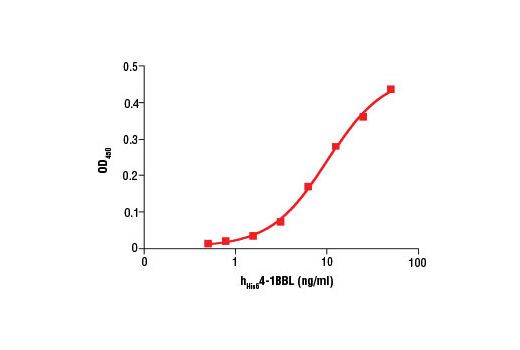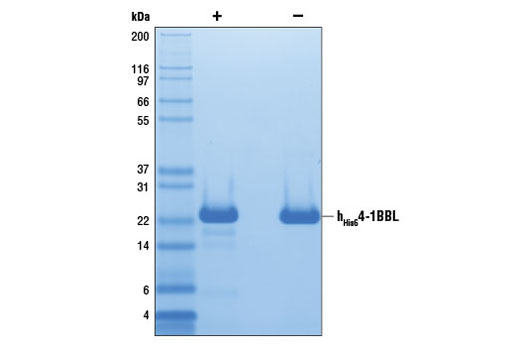22
#P41273
8744
Background
4-1BBL (also known as TNFSF9) is a member of the TNF-R superfamily, which includes OX40L, CD27L, CD40L, and GITRL (1). 4-1BBL is expressed primarily on antigen presenting cells, such as macrophages, dendritic cells, and B cells (2). 4-1BBL binds to 4-1BB on the surface of activated T cells (1). 4-1BBL/4-1BB binding activates the NF-κB pathway via TRAF1, 2, and 3 (1). 4-1BBL functions as a co-stimulatory molecule, inducing T cell proliferation, cytolytic activity, and cytokine production (2). Matrix metalloproteases can generate soluble 4-1BBL by cleaving it from the cell surface (3). The in vitro activity of soluble 4-1BBL is enhanced by cross-linking (4,5).
Endotoxin
Less than 0.01 ng endotoxin/1 μg hHis64-1BBL.
Purity
>98% as determined by SDS-PAGE of 6 μg reduced (+) and non-reduced (-) recombinant hHis64-1BBL. All lots are greater than 98% pure.
Source / Purification
Recombinant human His64-1BBL (hHis64-1BBL) Arg71-Glu254 (Accession #NP_003802) was expressed in human 293 cells at Cell Signaling Technology.
Bioactivity
The activity of hHis64-1BBL was assessed by its ability to bind to 4-1BB in a functional ELISA. The concentration at which half-maximal binding was observed for each lot was 6-18 ng/ml.
Background
4-1BBL (also known as TNFSF9) is a member of the TNF-R superfamily, which includes OX40L, CD27L, CD40L, and GITRL (1). 4-1BBL is expressed primarily on antigen presenting cells, such as macrophages, dendritic cells, and B cells (2). 4-1BBL binds to 4-1BB on the surface of activated T cells (1). 4-1BBL/4-1BB binding activates the NF-κB pathway via TRAF1, 2, and 3 (1). 4-1BBL functions as a co-stimulatory molecule, inducing T cell proliferation, cytolytic activity, and cytokine production (2). Matrix metalloproteases can generate soluble 4-1BBL by cleaving it from the cell surface (3). The in vitro activity of soluble 4-1BBL is enhanced by cross-linking (4,5).
Background References
Cross-Reactivity Key
H: human M: mouse R: rat Hm: hamster Mk: monkey Vir: virus Mi: mink C: chicken Dm: D. melanogaster X: Xenopus Z: zebrafish B: bovine Dg: dog Pg: pig Sc: S. cerevisiae Ce: C. elegans Hr: horse GP: Guinea Pig Rab: rabbit All: all species expected
Trademarks and Patents
Limited Uses
Except as otherwise expressly agreed in a writing signed by a legally authorized representative of CST, the following terms apply to Products provided by CST, its affiliates or its distributors. Any Customer's terms and conditions that are in addition to, or different from, those contained herein, unless separately accepted in writing by a legally authorized representative of CST, are rejected and are of no force or effect.
Products are labeled with For Research Use Only or a similar labeling statement and have not been approved, cleared, or licensed by the FDA or other regulatory foreign or domestic entity, for any purpose. Customer shall not use any Product for any diagnostic or therapeutic purpose, or otherwise in any manner that conflicts with its labeling statement. Products sold or licensed by CST are provided for Customer as the end-user and solely for research and development uses. Any use of Product for diagnostic, prophylactic or therapeutic purposes, or any purchase of Product for resale (alone or as a component) or other commercial purpose, requires a separate license from CST. Customer shall (a) not sell, license, loan, donate or otherwise transfer or make available any Product to any third party, whether alone or in combination with other materials, or use the Products to manufacture any commercial products, (b) not copy, modify, reverse engineer, decompile, disassemble or otherwise attempt to discover the underlying structure or technology of the Products, or use the Products for the purpose of developing any products or services that would compete with CST products or services, (c) not alter or remove from the Products any trademarks, trade names, logos, patent or copyright notices or markings, (d) use the Products solely in accordance with CST Product Terms of Sale and any applicable documentation, and (e) comply with any license, terms of service or similar agreement with respect to any third party products or services used by Customer in connection with the Products.

